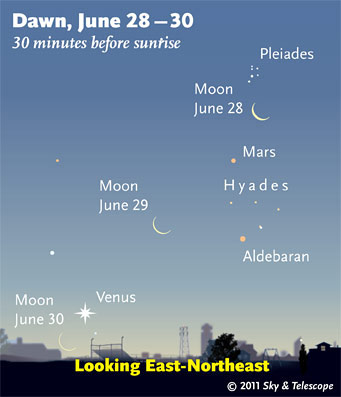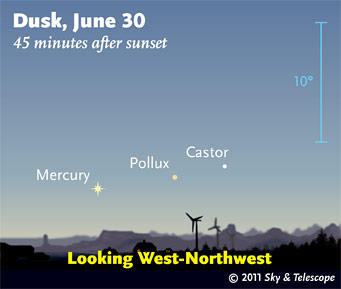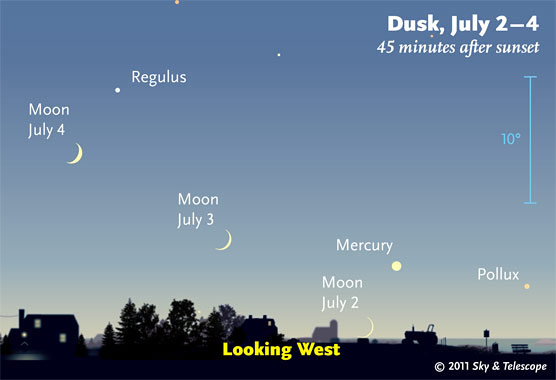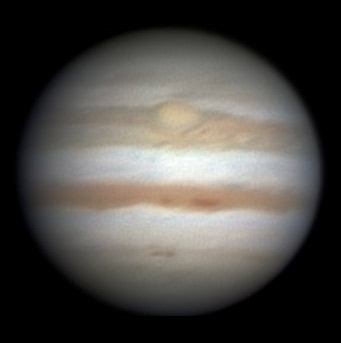
French observer Stéphane Lamotte Bailey created this animation of the Whirlpool galaxy's new supernova using images he took with his 8-inch telescope on May 30 and June 2, 2011.
St?©phane Lamotte Bailey
M51 Supernova update. Supernova 2011dh, which was discovered on May 31st at 14th magnitude in M51 (the Whirlpool Galaxy by the Big Dipper), seems to have topped out at magnitude 12.6. It's visible in many amateur telescopes now, especially with moonlight gone from the evening sky, but don't delay. Here's an up-to-date light curve from the American Association of Variable Star Observers. See our original article and finder photo. Plot an AAVSO comparison-star chart (enter the name SN 2011dh).
Friday, June 24
Saturday, June 25
Sunday, June 26

The waning Moon passes the Pleiades, Mars, and Aldebaran in the dawn. The visibility of the faint objects in bright twilight is exaggerated here. (These scenes are drawn for the middle of North America. European observers: move each Moon symbol a quarter of the way toward the one for the previous date. For clarity, the Moon is shown three times actual size.)
Sky & Telescope
Monday, June 27
You can create a new ephemeris for your exact observing location using the JPL Horizons ephemeris service. Enter the name 2011 MD.
And yes, there's now an iPhone app for this event (as part of the sky charting program Sky Safari 3).
Tuesday, June 28
Wednesday, June 29

All this week, Mercury climbs higher after sunset toward its June 30th lineup with fainter Pollux and Castor.
Sky & Telescope diagram
Thursday, June 30
Friday, July 1
Saturday, July 2

Watch the waxing crescent Moon thicken and advance eastward from day to day as July gets going.
Sky & Telescope diagram
.
Want to become a better amateur astronomer? Learn your way around the constellations. They're the key to locating everything fainter and deeper to hunt with binoculars or a telescope.
For an easy-to-use constellation guide covering the whole evening sky, use the big monthly map in the center of each issue of Sky & Telescope, the essential magazine of astronomy. Or download our free Getting Started in Astronomy booklet (which only has bimonthly maps).

The Pocket Sky Atlas plots 30,796 stars to magnitude 7.6 — which may sound like a lot, but that's less than one star in an entire telescopic field of view, on average. By comparison, Sky Atlas 2000.0 plots 81,312 stars to magnitude 8.5, typically one or two stars per telescopic field. Both atlases include many hundreds of deep-sky targets — galaxies, star clusters, and nebulae — to hunt among the stars.
Sky & Telescope
Once you get a telescope, to put it to good use you must have a detailed, large-scale sky atlas (set of charts). The standards are the Pocket Sky Atlas, which shows stars to magnitude 7.6; the larger Sky Atlas 2000.0 (stars to magnitude 8.5); and the even larger and deeper Uranometria 2000.0 (stars to magnitude 9.75). And read how to use sky charts effectively.
You'll also want a good deep-sky guidebook, such as Sky Atlas 2000.0 Companion by Strong and Sinnott, or the more detailed and descriptive Night Sky Observer's Guide by Kepple and Sanner, or the classic if dated Burnham's Celestial Handbook.
Can a computerized telescope take their place? I don't think so — not for beginners, anyway, and especially not on mounts that are less than top-quality mechanically. As Terence Dickinson and Alan Dyer say in their Backyard Astronomer's Guide, "A full appreciation of the universe cannot come without developing the skills to find things in the sky and understanding how the sky works. This knowledge comes only by spending time under the stars with star maps in hand."
This Week's Planet Roundup
Mercury (about magnitude –0.7) is deep in the glow of sunset. Try looking for it just above the west-northwest horizon about 40 minutes after sunset. Don't confuse it with fainter Pollux nearby, or with Regulus much higher due west.
Venus (magnitude –3.8) shines barely above the east-northeast horizon as dawn grows bright. Look for it about 20 minutes before sunrise.
Mars (magnitude +1.4) is low in east-northeast in early dawn, far lower left of Jupiter.

Jupiter is coming into better view now low in the dawn, but it's still very far from its best. Christopher Go obtained this fine stacked-video image on June 8th. Jupiter's dark South Equatorial Belt (above center) has fully returned and is very wide. The narrower North Equatorial Belt remains darker red-brown, with even darker barges. At the time of the photo the Great Red Spot had just barely passed the planet's central meridian (where the System II longitude was 163°). The SEB practically encompasses the Red Spot, and the Red Spot Hollow around the spot has changed from white to dark. South is up.
Jupiter (magnitude –2.2, in southern Aries) shines prominently in the east before and during dawn.
Saturn (magnitude +0.9, in Virgo) is southwest after dusk and getting lower. Shining 14° left of it is similar Spica. And just ½° to Saturn's upper right is fainter Porrima (Gamma Virginis), turning Saturn into a naked-eye "double star."
In a telescope Saturn's rings are 7.5° from edge on. The rings are casting a their shadow southward onto the globe as a thin black line, and the globe's shadow on the rings is visible just off the globe's celestial east (following) side. The North Equatorial Belt is a dusky band. North of it, Saturn's seven-months-old white outbreak is still apparent in good images, as shown here.
See how many of Saturn's satellites you can identify in your scope using our Saturn's Moons tracker.
And don't skip over Porrima — a fine, close telescopic binary with equal components and a current separation of 1.7 arcseconds. Use high power and hope for good seeing.
Uranus (magnitude 5.9, in western Pisces) and Neptune (magnitude 7.9, in Aquarius) are about equally high now just before the first light of dawn, in the southeast and south, respectively.
Pluto (magnitude 14.0, in Sagittarius) is highest in the south around 1 a.m. A big finder chart for it is in the July Sky & Telescope, page 64.
All descriptions that relate to your horizon — including the words up, down, right, and left — are written for the world's mid-northern latitudes. Descriptions that also depend on longitude (mainly Moon positions) are for North America. Eastern Daylight Time (EDT) equals Universal Time (also known as UT, UTC, or GMT) minus 4 hours.
To be sure to get the current Sky at a Glance, bookmark this URL:
http://SkyandTelescope.com/observing/ataglance?1=1
If pictures fail to load, refresh the page. If they still fail to load, change the 1 at the end of the URL to any other character and try again.
 0
0
Comments
You must be logged in to post a comment.